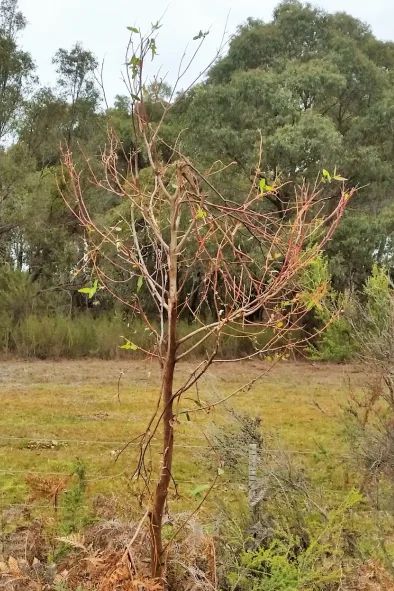Koalas have overbred like rabbits. But the Greenies ignore this of course as they want to stop logging of the forests.
'They're like rabbits': Wildlife experts call for post-fires koala plan
By Rachael Dexter January 23, 2020 — 7.30pm
 Wildlife experts have called for a long-term management plan for Victoria's koalas and, in the wake of devastating bushfires, warned against well-intentioned public appeals that may distract from measures needed to stabilise the species.
Wildlife experts have called for a long-term management plan for Victoria's koalas and, in the wake of devastating bushfires, warned against well-intentioned public appeals that may distract from measures needed to stabilise the species.
Australia's koala population has gained worldwide attention and raised millions of dollars as shocking images continue to emerge of burnt koalas during the ongoing bushfire season.
"There are so many misconceptions among the public," says Dr Desley Whisson, a lecturer in Wildlife and Conservation Biology at Deakin University.
Dr Whisson says many people are unaware that in some areas koalas are over-populating which strips habitats of enough food - leading to food scarcity and, in the worst cases, starvation.
French Island in Victoria's Western Port is home to a large population of koalas that were introduced to the predator-free island in the 1890s, in an effort to rescue the species after hunting decimated numbers on the mainland.
The animals were then used to repopulate the mainland, and now their descendants are widespread across Victoria, and as far as Kangaroo Island in South Australia.

A koala on the roadside on French Island, where local ecologist Chris Chandler estimates there are at least one thousand too many bears for the habitat to sustain.CREDIT:RACHAEL DEXTER
At the weekend, a bushfire burned more than 85 hectares of national park on French Island, raising fears for the koala population - a major drawcard for the hamlet island of 100 people.
Local ecologist and treasurer of the Friends of French Island volunteer group Chris Chandler estimates the local population to be around 3000, on an island of 170 square kilometres.
“They're phenomenal, they’re like rabbits,” he said.
But he says these koalas, or 'teddies’ as locals refer to them, have exploded in numbers to the detriment of the island's manna gum and swamp gum woodlands.
A retired CFA captain has lost almost half a million dollars’ worth of property on French Island, as he was protecting the township rather than his own property.
Koalas typically eat around four kilograms of eucalyptus leaves per day, and a healthy ratio is considered one koala per hectare according to the Department of Land, Water and Planning.
In the past, the DELWP estimated there were up to eight koalas per hectare on French Island - which led to an intervention.
In 2017, more than 400 sterilised French Island koalas were relocated to Kinglake, due to lack of food for them on the island.
Commonwealth law prohibits koala culls which means states are limited in ways to manage over-abundance, said Dr Whisson.

A koala sits in an 'overgrazed' Eucalypt tree on French Island. CREDIT:CHRIS CHANDLER
“There's two options really – there's fertility control and translocation," she said.
But both options have downsides: the capture, sterilisation and release of koalas is expensive and needs to be done at a large scale to make a significant impact on overpopulated areas – while translocation has its own pitfalls.

A young manna gum tree broken by hungry French Island koalas. Over grazing can kill trees completely.CREDIT:CHRIS CHANDLER
"Having places to put koalas is becoming more and more of an issue, because most habitats are already full,” she said.
Introduced French Island koalas exploded in numbers in the Otway National Park, which eventually resulted in 700 starving koalas being euthanised in 2013 and 2014.
In the wake of bushfires that have torn through wildlife, translocation may be on the table again in years to come.
A spokesperson from the Department of Land, Water and Planning said the impacts of the fires on French Island and the koala population are still being assessed.
"If there are any impacted koalas on French Island and there is no suitable unoccupied habitat available on the island then these animals will be taken into care and released as suitable habitat is identified," they said.
Mr Chandler slammed the 2017 koala Kinglake relocation as a waste of money and a ‘purely emotional response’, as the koalas were all sterilised before being relocated.
“It just created a retirement village for dying koalas in Kinglake”.
In the wake of this season’s bushfires, which scientists fear may have killed 'many billions' of animals nation-wide, both Dr Whisson and Mr Chandler want to see government resources focused on preserving genetically-diverse koala species.
“Most people think we have lots of koalas, but in actual fact that doesn’t mean we have a stable population,” said Mr Chandler.
“All the koalas from French Island are really closely related, so if we ever got an epidemic of a new disease, they wouldn’t survive”.
Koala's found in the Strzelecki Ranges in south-eastern Victoria, for example, have been found to be more genetically diverse, and therefore more resilient to possible disease epidemics.

A Koala in Cape Otway in a stripped Manna Gum tree. Koalas were re-introduced to Cape Otway in the 1970s, sourced mainly from French Island. CREDIT:DESLEY WHISSON
Dr Whisson said she was frustrated by a lack of a 'long-term management plan' across the state, and hoped the current public focus on Australia's wildlife could fuel a rethink at government level.
“We need a state-wide strategy that addresses both the overabundant populations and areas where populations might be declining,” she said.
“I would like to see some evidence-based decisions, and some of those aren’t going to be particularly acceptable to the public, but what else do you do?”
“You can’t just keep going doing ad hoc management”.
https://www.theage.com.au/national/vict ... 53t1x.html







